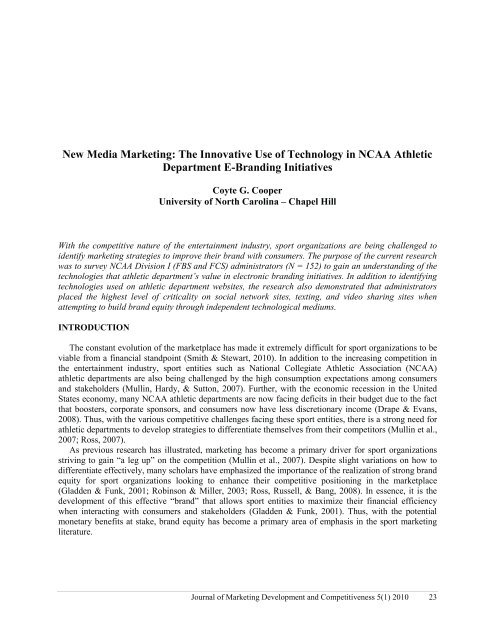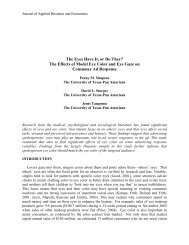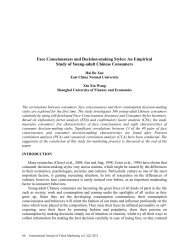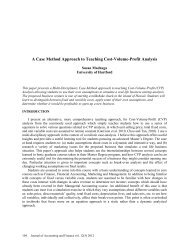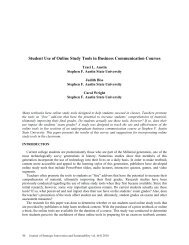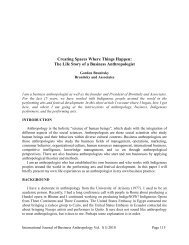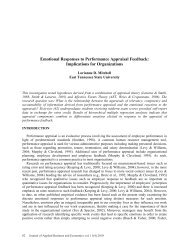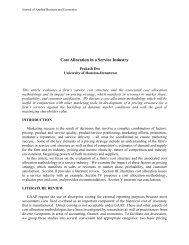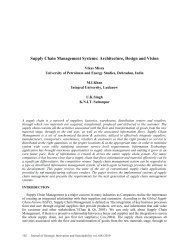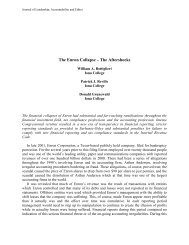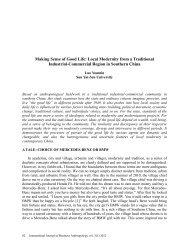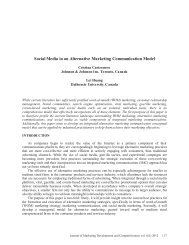New Media Marketing: The Innovative Use of Technology in NCAA ...
New Media Marketing: The Innovative Use of Technology in NCAA ...
New Media Marketing: The Innovative Use of Technology in NCAA ...
Create successful ePaper yourself
Turn your PDF publications into a flip-book with our unique Google optimized e-Paper software.
<strong>New</strong> <strong>Media</strong> <strong>Market<strong>in</strong>g</strong>: <strong>The</strong> <strong>Innovative</strong> <strong>Use</strong> <strong>of</strong> <strong>Technology</strong> <strong>in</strong> <strong>NCAA</strong> AthleticDepartment E-Brand<strong>in</strong>g InitiativesCoyte G. CooperUniversity <strong>of</strong> North Carol<strong>in</strong>a – Chapel HillWith the competitive nature <strong>of</strong> the enterta<strong>in</strong>ment <strong>in</strong>dustry, sport organizations are be<strong>in</strong>g challenged toidentify market<strong>in</strong>g strategies to improve their brand with consumers. <strong>The</strong> purpose <strong>of</strong> the current researchwas to survey <strong>NCAA</strong> Division I (FBS and FCS) adm<strong>in</strong>istrators (N = 152) to ga<strong>in</strong> an understand<strong>in</strong>g <strong>of</strong> thetechnologies that athletic department’s value <strong>in</strong> electronic brand<strong>in</strong>g <strong>in</strong>itiatives. In addition to identify<strong>in</strong>gtechnologies used on athletic department websites, the research also demonstrated that adm<strong>in</strong>istratorsplaced the highest level <strong>of</strong> criticality on social network sites, text<strong>in</strong>g, and video shar<strong>in</strong>g sites whenattempt<strong>in</strong>g to build brand equity through <strong>in</strong>dependent technological mediums.INTRODUCTION<strong>The</strong> constant evolution <strong>of</strong> the marketplace has made it extremely difficult for sport organizations to beviable from a f<strong>in</strong>ancial standpo<strong>in</strong>t (Smith & Stewart, 2010). In addition to the <strong>in</strong>creas<strong>in</strong>g competition <strong>in</strong>the enterta<strong>in</strong>ment <strong>in</strong>dustry, sport entities such as National Collegiate Athletic Association (<strong>NCAA</strong>)athletic departments are also be<strong>in</strong>g challenged by the high consumption expectations among consumersand stakeholders (Mull<strong>in</strong>, Hardy, & Sutton, 2007). Further, with the economic recession <strong>in</strong> the UnitedStates economy, many <strong>NCAA</strong> athletic departments are now fac<strong>in</strong>g deficits <strong>in</strong> their budget due to the factthat boosters, corporate sponsors, and consumers now have less discretionary <strong>in</strong>come (Drape & Evans,2008). Thus, with the various competitive challenges fac<strong>in</strong>g these sport entities, there is a strong need forathletic departments to develop strategies to differentiate themselves from their competitors (Mull<strong>in</strong> et al.,2007; Ross, 2007).As previous research has illustrated, market<strong>in</strong>g has become a primary driver for sport organizationsstriv<strong>in</strong>g to ga<strong>in</strong> “a leg up” on the competition (Mull<strong>in</strong> et al., 2007). Despite slight variations on how todifferentiate effectively, many scholars have emphasized the importance <strong>of</strong> the realization <strong>of</strong> strong brandequity for sport organizations look<strong>in</strong>g to enhance their competitive position<strong>in</strong>g <strong>in</strong> the marketplace(Gladden & Funk, 2001; Rob<strong>in</strong>son & Miller, 2003; Ross, Russell, & Bang, 2008). In essence, it is thedevelopment <strong>of</strong> this effective “brand” that allows sport entities to maximize their f<strong>in</strong>ancial efficiencywhen <strong>in</strong>teract<strong>in</strong>g with consumers and stakeholders (Gladden & Funk, 2001). Thus, with the potentialmonetary benefits at stake, brand equity has become a primary area <strong>of</strong> emphasis <strong>in</strong> the sport market<strong>in</strong>gliterature.Journal <strong>of</strong> <strong>Market<strong>in</strong>g</strong> Development and Competitiveness 5(1) 2010 23
BRAND EQUITYBrand equity has been characterized by the assets l<strong>in</strong>ked to a brand’s name that add consumer value tothe product be<strong>in</strong>g <strong>of</strong>fered by a bus<strong>in</strong>ess entity (Aaker, 1991). In a pioneer study on brand management,Gardner and Levy (1955) expla<strong>in</strong>ed that “a brand name is more than the label employed to differentiateamong manufacturers <strong>of</strong> a product. It is a complex symbol that represents a variety <strong>of</strong> ideas andattributes” (p. 34). Similarly, this understand<strong>in</strong>g <strong>of</strong> brand management was clarified when Brandt andJohnson (1997) described brand as a comb<strong>in</strong>ation <strong>of</strong> the physical product, <strong>in</strong>tangible values, andconsumer expectations attached to a product by a consumer. Thus, it is the successful implementation <strong>of</strong>these public associations that allows a sport organization to build brand equity <strong>in</strong> a productive manner(Dickey & Lewis, 2009).From a practical standpo<strong>in</strong>t, sport organizations are allowed to differentiate themselves <strong>in</strong> acompetitive marketplace by develop<strong>in</strong>g a brand that portrays a promise to consistently deliver specificfeatures, benefits, and/or services to buyers (Kaferer, 1992). In coord<strong>in</strong>ation with the successfulcommunication <strong>of</strong> these associations, sport organizations are afforded with the opportunity to develop astrong brand image with<strong>in</strong> their surround<strong>in</strong>g communities (Brandt & Johnson, 1997; Dickey & Lewis,2009; Gardner & Levy, 1955). Further, the pursuit <strong>of</strong> effective brand management is desirable becausestrong brand equity has been associated with the follow<strong>in</strong>g monetary benefits: enhanced product value(Dodds, Monroe, & Grewal, 1991; Keller, 2003), improved purchase <strong>in</strong>tention (Cobb-Walgren, Ruble, &Donthu, 1995), and immunity to product-associated crises (Dewar & Pillutla, 2000). Further, whenfocus<strong>in</strong>g on college athletics, scholars have demonstrated that sport organizations with strong brandequity are less likely to lose fans when their team struggles from a performance standpo<strong>in</strong>t (Gladden,Milne, & Sutton, 1998). Thus, with the valuable benefits afforded to sport organizations, there is agrow<strong>in</strong>g need to understand the new media strategies that <strong>NCAA</strong> athletic department’s value whenattempt<strong>in</strong>g to communicate their brand effectively with consumers and stakeholders.Electronic Brand<strong>in</strong>gDur<strong>in</strong>g the past decade, the Internet has drastically changed the way that bus<strong>in</strong>ess organizationsmanage their brand (de Chernatony, 2006). With the popularization <strong>of</strong> <strong>in</strong>teractive devices available viathe Internet, brand management pr<strong>in</strong>ciples dictate the need for utiliz<strong>in</strong>g blogs, podcast<strong>in</strong>g, and socialnetwork sites (e.g., Facebook) to build and enhance brand image with consumers (Christodoulides, 2009).However, despite the undeniable importance <strong>of</strong> modern communication with consumers and stakeholders,there is a lack <strong>of</strong> empirical evidence focus<strong>in</strong>g on the electronic brand<strong>in</strong>g strategies available <strong>in</strong> the sport<strong>in</strong>dustry (Van den Bulte & Wuyts, 2007). Thus, there is a strong need for research that exam<strong>in</strong>es thepotential uses <strong>of</strong> technological mediums as part <strong>of</strong> the overall market<strong>in</strong>g plan (de Chernatony &Christoudoulides, 2004). Prior to discuss<strong>in</strong>g the method implemented <strong>in</strong> the current study, signal<strong>in</strong>gtheory will be discussed as a theoretical framework for the research.THEORETICAL FRAMEWORKWhen focus<strong>in</strong>g on market<strong>in</strong>g-based research, signal<strong>in</strong>g theory has been used as a framework tounderstand how consumers come to recognize a brand (Aaker, 1996). In essence, brand awareness iscreated when directed signals (communication and related market<strong>in</strong>g activities) are sent to consumers <strong>of</strong> aproduct (Erdem & Swait, 1998). When a market<strong>in</strong>g signal is strong, then the <strong>in</strong>teraction creates consumervalue through the reduction <strong>of</strong> <strong>in</strong>formation search costs and perceived risk <strong>of</strong> purchase (Christodoulides,de Chernatony, Furrer, Shiu, & Abimbola, 2006). Further, with consistency <strong>in</strong> the communicationprocess, the <strong>in</strong>formation creates a credible signal that <strong>in</strong>creases the brand equity <strong>of</strong> the sport organizationdeliver<strong>in</strong>g the content (Christodoulides et al., 2006). Thus, as previously discussed, sport organizationsare able to use this understand<strong>in</strong>g to improve the <strong>in</strong>teractions with their consumers, and as a result theyare able to realize all the monetary benefits associated with strong brand equity (Cobb-Walgren et al.,1995; Gladden et al., 1998; Keller, 2003).24 Journal <strong>of</strong> <strong>Market<strong>in</strong>g</strong> Development and Competitiveness 5(1) 2010
While the previous brand<strong>in</strong>g strategies have been proposed <strong>in</strong> conceptual models, there is littleempirical evidence that is available on the technologies that are implemented by <strong>NCAA</strong> athleticdepartments <strong>in</strong> their brand<strong>in</strong>g efforts. With the grow<strong>in</strong>g popularity <strong>of</strong> new media applications <strong>in</strong> popularculture (Christodoulides, 2009), there is a grow<strong>in</strong>g need to understand the way that technology is used to<strong>in</strong>teract with consumers <strong>in</strong> sport sett<strong>in</strong>gs. With this <strong>in</strong> m<strong>in</strong>d, the purpose <strong>of</strong> the current research was tosurvey <strong>NCAA</strong> Division I (Football Bowl Subdivision [FBS] and Football Championship Subdivision[FCS]) adm<strong>in</strong>istrators to ga<strong>in</strong> an understand<strong>in</strong>g <strong>of</strong> the technologies that athletic department’s value <strong>in</strong>electronic brand<strong>in</strong>g <strong>in</strong>itiatives. Based on a review <strong>of</strong> the related electronic brand<strong>in</strong>g (e-brand<strong>in</strong>g)literature, the follow<strong>in</strong>g research questions were created to guide the study:[RQ 1]: What technologies do <strong>NCAA</strong> Division I Football Bowl Subdivision (FBS) and FootballChampionship (FCS) athletic adm<strong>in</strong>istrators feel are critical when engag<strong>in</strong>g <strong>in</strong> electronicbrand<strong>in</strong>g strategies with consumers and stakeholders via their websites?[RQ 2]: What technologies do <strong>NCAA</strong> Division I Football Bowl Subdivision (FBS) and FootballChampionship (FCS) athletic adm<strong>in</strong>istrators feel are critical when engag<strong>in</strong>g <strong>in</strong> electronicbrand<strong>in</strong>g strategies with consumers and stakeholders via <strong>in</strong>dependent mediums?[RQ 3]: What role does <strong>NCAA</strong> Division I Football Bowl Subdivision (FBS) and FootballChampionship (FCS) athletic adm<strong>in</strong>istrators feel that technology will play when engag<strong>in</strong>g <strong>in</strong>electronic brand<strong>in</strong>g strategies with consumers and stakeholders <strong>in</strong> the future?METHODSample<strong>The</strong> current research featured an onl<strong>in</strong>e survey designed to understand the technologies that <strong>NCAA</strong>Division I (FBS and FCS) athletic departments’ value <strong>in</strong> their e-brand<strong>in</strong>g <strong>in</strong>itiatives. <strong>The</strong> Division I levelwas chosen as a sampl<strong>in</strong>g frame because it represents the <strong>NCAA</strong> athletic departments operat<strong>in</strong>g at thehighest level <strong>of</strong> college athletics from a competitive and f<strong>in</strong>ancial standpo<strong>in</strong>t. In order to ensure arepresentative sample, an email <strong>in</strong>vitation was sent to the senior athletic adm<strong>in</strong>istrators at each <strong>of</strong> the<strong>in</strong>stitutions <strong>in</strong> the areas most closely correspond<strong>in</strong>g to the brand<strong>in</strong>g research topic (e.g., Senior AssociateAthletic Director <strong>in</strong> <strong>Market<strong>in</strong>g</strong>). As a precaution to avoid duplication <strong>in</strong> the responses, the adm<strong>in</strong>istratorswere asked to have only one <strong>in</strong>dividual per athletic department respond to the survey. Follow<strong>in</strong>g the tworounds <strong>of</strong> <strong>in</strong>vitations (with one month lapse between emails), there were a total <strong>of</strong> 152 <strong>NCAA</strong> Division Iathletic departments (FBS [n = 64]; FCS [n = 88]) that participated <strong>in</strong> the research. Thus, the sample wasrepresentative <strong>of</strong> well over 50% <strong>of</strong> the <strong>NCAA</strong> FBS and FCS athletic departments featured at the DivisionI level.Research Instrument<strong>The</strong> current research utilized a 16-item survey <strong>in</strong>strument to ga<strong>in</strong> an understand<strong>in</strong>g <strong>of</strong> the e-brand<strong>in</strong>gstrategies that <strong>NCAA</strong> athletic departments use when <strong>in</strong>teract<strong>in</strong>g with their consumers. Based onconsultation with a panel <strong>of</strong> market<strong>in</strong>g experts (one athletic adm<strong>in</strong>istrator [market<strong>in</strong>g], two sportmanagement researchers [market<strong>in</strong>g], and one expert <strong>in</strong> research design), the decision was made to<strong>in</strong>clude six electronic brand<strong>in</strong>g questions (with subscale items) <strong>in</strong> three primary categories: (1) athleticdepartment websites, (2) <strong>in</strong>dependent media outlets, and (3) the role <strong>of</strong> technology <strong>in</strong> future brand<strong>in</strong>g<strong>in</strong>itiatives (see Table 1). For the questions featured <strong>in</strong> these sections, a six-po<strong>in</strong>t Likert-type scale(1=strongly disagree; 6=strongly agree) was used to identify that strategies that adm<strong>in</strong>istrators view ascritical <strong>in</strong> today’s college sport <strong>in</strong>dustry. In addition, the survey collected market<strong>in</strong>g-based background<strong>in</strong>formation (e.g., FBS/FCS conference affiliation, market<strong>in</strong>g budget, market<strong>in</strong>g employees, contentcontrol on website, frequency <strong>of</strong> website updates) on the athletic departments participat<strong>in</strong>g <strong>in</strong> theresearch.Journal <strong>of</strong> <strong>Market<strong>in</strong>g</strong> Development and Competitiveness 5(1) 2010 25
Data AnalysisDescriptive statistics were used <strong>in</strong> the research to understand the e-brand<strong>in</strong>g strategies that <strong>NCAA</strong>athletic departments implement <strong>in</strong> their <strong>in</strong>teractions with consumers. In addition to the calculation <strong>of</strong>means and standard deviations for the survey items, the research also used one sample t-tests to identifythe technologies that are critical <strong>in</strong> e-brand<strong>in</strong>g efforts. Further, a one-way ANOVA was used to identifythe significant differences <strong>in</strong> the use <strong>of</strong> technologies when focus<strong>in</strong>g on the FBS and FCS affiliation <strong>of</strong>athletic departments participat<strong>in</strong>g <strong>in</strong> the research. <strong>The</strong> purpose <strong>of</strong> this statistical analysis was to identify ifvary<strong>in</strong>g e-brand<strong>in</strong>g philosophies exist between FBS and FCS schools with vary<strong>in</strong>g levels <strong>of</strong> athleticbudgets. Thus, the statistical analyses <strong>of</strong>fered a unique opportunity to understand e-brand<strong>in</strong>g strategiesimplemented with<strong>in</strong> FBS athletic departments.TABLE 1SURVEY ITEMS RELATED TO ELECTRONIC BRANDING STRATEGIESSurvey SectionAthletic Department WebsiteIndependent <strong>Media</strong> PlatformsRole <strong>of</strong> <strong>Technology</strong> <strong>in</strong> FutureQuestion<strong>The</strong> follow<strong>in</strong>g website technologies are critical when attempt<strong>in</strong>g to buildbrand image with consumers on your athletic website:Audio BroadcastsBlogsInteractive Chat (Coaches/Players)Interactive Fan PollsMessage Boards<strong>New</strong>slettersPodcastsVideo Broadcasts<strong>The</strong> follow<strong>in</strong>g <strong>in</strong>dependent communication mediums are critical whenattempt<strong>in</strong>g to build your brand image with consumers:BlogsMessage BoardsMobile ApplicationsPodcastsSocial Network SitesText Messag<strong>in</strong>gTwitter<strong>in</strong>gVideo Shar<strong>in</strong>g SitesSocial network sites will become a primary database market<strong>in</strong>g tool to reachyounger fan segments.Video shar<strong>in</strong>g sites will become a primary market<strong>in</strong>g tool for organizationslook<strong>in</strong>g to build their brand image with consumers.Database text messag<strong>in</strong>g will play a much larger role when promot<strong>in</strong>g eventsto consumers.Younger generations will cont<strong>in</strong>ue to grow more reliant on the Internet andtechnology <strong>in</strong> the future.Note. Six-Po<strong>in</strong>t Likert scale used to rank items (1=strongly disagree; 6=strongly agree).26 Journal <strong>of</strong> <strong>Market<strong>in</strong>g</strong> Development and Competitiveness 5(1) 2010
RESULTS<strong>The</strong> <strong>in</strong>vestigation <strong>of</strong> the data illustrated that there were a variety <strong>of</strong> different FBS (n = 64) and FCS (n= 88) athletic departments represented <strong>in</strong> the sample. When focus<strong>in</strong>g on the background <strong>in</strong>formation <strong>of</strong>the <strong>in</strong>stitutions, the results illustrated that FBS conferences on average had four employees and a budget<strong>of</strong> $150,000 for market<strong>in</strong>g purposes. In contrast, FCS <strong>in</strong>stitutions had an average <strong>of</strong> two employees and abudget <strong>of</strong> $75,000 for market<strong>in</strong>g purposes. Further, when exam<strong>in</strong><strong>in</strong>g the usage <strong>of</strong> athletic websites, thedata demonstrated similar trends <strong>in</strong> the control <strong>of</strong> content (FBS = 78% control site content; FCS = 86%control site content) and frequency <strong>of</strong> updates on their websites (both update multiple times daily). <strong>The</strong>rema<strong>in</strong><strong>in</strong>g responses to the criticality <strong>of</strong> electronic brand<strong>in</strong>g strategies will be discussed <strong>in</strong> the follow<strong>in</strong>gthree sections.E-Brand<strong>in</strong>g on Athletic WebsitesAs shown <strong>in</strong> Table 2, the mean and standard deviations (Division I [Overall], FBS, and FCS) werecalculated for each <strong>of</strong> the “athletic department website” subscale items <strong>in</strong>cluded <strong>in</strong> the survey <strong>in</strong>strument.In addition, a one-sample T-Test was conducted on each <strong>of</strong> the items to <strong>in</strong>vestigate Research Question 1.When focus<strong>in</strong>g on all <strong>of</strong> the <strong>in</strong>stitutions at the Division I level, four <strong>of</strong> the website technologies were p=.05 level: video broadcasts [t(151) = 12.58, p
athletic adm<strong>in</strong>istrators placed a significantly higher criticality on the importance <strong>of</strong> social network l<strong>in</strong>ks[F(1,149) = 17.63, p < .05] when <strong>in</strong> comparison to FBS adm<strong>in</strong>istrators. In contrast, the results alsosupported the notion that FBS adm<strong>in</strong>istrators placed a higher criticality on podcasts [F(1,150) = 8.96, p
affiliation <strong>of</strong> athletic departments, the data supported the notion that FCS adm<strong>in</strong>istrators placed a higherlevel <strong>of</strong> criticality on video shar<strong>in</strong>g <strong>in</strong> future e-brand<strong>in</strong>g <strong>in</strong>itiatives than FBS adm<strong>in</strong>istrators [F(1,136) =7.28, p < .05].DISCUSSIONWith the role <strong>of</strong> successful communication <strong>in</strong> build<strong>in</strong>g brand equity with consumers (Dickey & Lewis,2009), it is extremely important that <strong>NCAA</strong> athletic departments effectively use new media when<strong>in</strong>teract<strong>in</strong>g with consumers (Christodoulides, 2009). In fact, with the grow<strong>in</strong>g popularity <strong>of</strong> new mediaamong younger generations <strong>of</strong> consumers, it seems likely that Internet-based applications will cont<strong>in</strong>ue toplay a larger role <strong>in</strong> the way that sport organizations send market<strong>in</strong>g-based signals to current and potentialfan segments. With that be<strong>in</strong>g said, research has emphasized the need to ensure that <strong>NCAA</strong> athleticdepartments are us<strong>in</strong>g the right technological mediums to reach consumers so that they are maximiz<strong>in</strong>gtheir opportunity to build organizational brand equity <strong>in</strong> the marketplace (Christodoulides, 2009).TABLE 4<strong>NCAA</strong> ATHLETIC ADMINISTRATORS ON ROLE OF TECHNOLOGY IN THE FUTUREDivision I FBS FCSM SD M SD M SDSocial Network Sites 4.83* 1.05 4.67* 1.19 4.93* 0.95Video Shar<strong>in</strong>g 4.68* 1.10 4.38 1.21 4.89* 0.97Text<strong>in</strong>g 4.81* 1.01 4.78* 1.09 4.84* 0.95Reliance on Internet and <strong>Technology</strong> 5.61* 0.86 5.55* 1.03 5.65* 0.72Note. <strong>The</strong> scale ranged from Strongly Disagree (1) to Strongly Agree (6). <strong>The</strong> Division I categoryencompassed all <strong>NCAA</strong> athletic departments and FBS and FCS categories featured segmented responses.*p < .05 ()<strong>NCAA</strong> E-Brand<strong>in</strong>g Trends<strong>The</strong>re are several results with<strong>in</strong> the current research that are worth not<strong>in</strong>g when discuss<strong>in</strong>g theimplications <strong>of</strong> build<strong>in</strong>g organizational brand equity. When focus<strong>in</strong>g on the trends present at the DivisionI level, it seems evident that athletic adm<strong>in</strong>istrators value the audio and visual delivery <strong>of</strong> content on theirhome websites when attempt<strong>in</strong>g to build their brand with consumers. With the <strong>in</strong>novative capabilitiesavailable through these technologies, it makes sense that <strong>NCAA</strong> athletic departments would value thesestrategies as a viable e-brand<strong>in</strong>g mechanism on their home websites. In fact, the use <strong>of</strong> <strong>in</strong>timate videomessages (signals) from head coaches (e.g., Nick Saban) is one example <strong>of</strong> how athletic departments canuse these technologies to build brand loyalty with consumers. Thus, when comb<strong>in</strong>ed with effectivetechnological delivery strategies, the received signals have the capability to br<strong>in</strong>g several monetarybenefits that come from the realization <strong>of</strong> strong brand equity with consumers (Cobb-Walgren et al.,1995; Gladden et al., 1998; Keller, 2003).In addition to the use <strong>of</strong> technologies on athletic websites, athletic departments have also turned to<strong>in</strong>dependent technologies <strong>in</strong> order to build their brand equity with consumers. Not surpris<strong>in</strong>gly, with thegrow<strong>in</strong>g popularity <strong>of</strong> the Internet, adm<strong>in</strong>istrators have identified social network and video shar<strong>in</strong>g sitesas the primary e-brand<strong>in</strong>g outlets when communicat<strong>in</strong>g messages with current and potential fan segments.Further, with the <strong>in</strong>creas<strong>in</strong>g focus on mobile market<strong>in</strong>g, athletic departments have also emphasized textmessag<strong>in</strong>g as a critical outlet to deliver signals effectively <strong>in</strong> the marketplace. In essence, it is the efficientuse <strong>of</strong> these new media outlets that allow athletic departments to build their brand equity with youngergenerations <strong>of</strong> consumer segments (Christodoulides, 2009).Journal <strong>of</strong> <strong>Market<strong>in</strong>g</strong> Development and Competitiveness 5(1) 2010 29
In direct contrast to the previous sections, the results also illustrated the technologies thatadm<strong>in</strong>istrators felt were least valuable <strong>in</strong> electronic brand<strong>in</strong>g <strong>in</strong>itiatives. As discussed <strong>in</strong> the results,message boards were rated as the least beneficial technology when attempt<strong>in</strong>g to communicate withconsumers on athletic department’s home website. Similarly, this type <strong>of</strong> medium was also shown to bethe least critical technology when engag<strong>in</strong>g <strong>in</strong> brand<strong>in</strong>g strategies through <strong>in</strong>dependent media platforms.While there are a variety <strong>of</strong> reasons for this lack <strong>of</strong> <strong>in</strong>terest among adm<strong>in</strong>istrators, the explanation canmost likely be found <strong>in</strong> the fact that there is so much negativity communicated by consumers on messageboards. In fact, the anonymous nature <strong>of</strong> these mediums <strong>of</strong>ten allows fans to “bash” on coaches, studentathletes,and staff members with<strong>in</strong> <strong>NCAA</strong> athletic departments. Thus, with conflict<strong>in</strong>g messages be<strong>in</strong>gdelivered through message boards, it seems reasonable that athletic departments would attempt to avoidthese types <strong>of</strong> technologies. After all, the negative publicity could send unconstructive messages thatcould hurt the brand equity <strong>of</strong> the athletic department (Christodoulides et al., 2006).E-Brand<strong>in</strong>g <strong>in</strong> FBS and FCS Institutions<strong>The</strong> previous results demonstrated that there were clearly technologies that all <strong>NCAA</strong> Division Iathletic departments embrace <strong>in</strong> their pursuit to build their brand equity with consumers. However, theanalysis also supported the notion that FBS and FCS <strong>in</strong>stitutions had slight variations <strong>in</strong> e-brand<strong>in</strong>g<strong>in</strong>itiatives that they engaged <strong>in</strong>. <strong>The</strong> fact that FBS <strong>in</strong>stitutions placed a higher value on podcasts is notsurpris<strong>in</strong>g consider<strong>in</strong>g the fact that these <strong>in</strong>stitutions have significantly more money to spend on thedevelopment <strong>of</strong> <strong>in</strong>timate videos as content. Further, the variation <strong>in</strong> the use <strong>of</strong> microblogg<strong>in</strong>g (higher forFCS) as a tool to build brand equity is expla<strong>in</strong>ed by the fact that many Division I athletic departmentshave <strong>in</strong>dependent entities that carry out Twitter feeds for them. In contrast, without this type <strong>of</strong> attention,FCS <strong>in</strong>stitutions are reliant on microblogg<strong>in</strong>g sites such as Twitter to communicate with consumers.<strong>The</strong> Future <strong>of</strong> E-Brand<strong>in</strong>gIn addition to the various technologies, the current research also focused on future role <strong>of</strong> technologies<strong>in</strong> e-brand<strong>in</strong>g efforts. <strong>The</strong> results unanimously support the notion that adm<strong>in</strong>istrators feel that new mediawill play a major role <strong>in</strong> market<strong>in</strong>g <strong>in</strong>itiatives <strong>in</strong> the future. In particular, the data illustrated the fact thatathletic departments anticipate a stronger emphasis on technologies when attempt<strong>in</strong>g to effectivelycommunicate with consumers <strong>in</strong> future years. Further, with<strong>in</strong> this context, adm<strong>in</strong>istrators <strong>in</strong>dicated thatsocial network sites, text<strong>in</strong>g, and video shar<strong>in</strong>g sites will cont<strong>in</strong>ue to play a major role <strong>in</strong> build<strong>in</strong>g brandequity <strong>in</strong> the marketplace. Thus, there is a grow<strong>in</strong>g need to understand the way that these technologies arebe<strong>in</strong>g used to communicate with consumers.<strong>The</strong> Bottom L<strong>in</strong>e<strong>The</strong> bottom l<strong>in</strong>e is that sport organizations must capitalize on new media opportunities if they arego<strong>in</strong>g to be successful <strong>in</strong> future market<strong>in</strong>g endeavors (Christodoulides, 2009). As part <strong>of</strong> this process,adm<strong>in</strong>istrators (and market<strong>in</strong>g employees) must <strong>in</strong>vest <strong>in</strong> technologies that allow them to communicateeffectively with younger generations <strong>of</strong> consumers. In essence, the effective use <strong>of</strong> new media providesathletic departments with a channel to communicate messages that build credibility with consumers whothey are target<strong>in</strong>g. Thus, when this message is strong, <strong>NCAA</strong> athletic departments have the opportunity tocreate consumer value through the reduction <strong>of</strong> <strong>in</strong>formation search costs and perceived risk <strong>of</strong> purchase(Christodoulides et al., 2006). As a result, they are provided with all <strong>of</strong> the monetary benefits (e.g., repeatpurchas<strong>in</strong>g) that are associated with strong organizational brand equity (Cobb-Walgren et al., 1995;Gladden et al., 1998; Keller, 2003).CONCLUSIONSBased on the results <strong>in</strong> the research, it is clear that technology will play a major role <strong>in</strong> thecommunication <strong>of</strong> market<strong>in</strong>g-based signals to younger generations <strong>of</strong> consumers <strong>in</strong> future years. Whenconsider<strong>in</strong>g the fact that younger consumers represent a significant portion <strong>of</strong> future revenues for sport30 Journal <strong>of</strong> <strong>Market<strong>in</strong>g</strong> Development and Competitiveness 5(1) 2010
organizations, it becomes extremely important that these <strong>NCAA</strong> athletic departments identify andleverage new media outlets that allow them to communicate effectively with this particular consumersegment. Thus, the current research <strong>of</strong>fers an <strong>in</strong>itial opportunity to understand the technologies thatathletic departments deem as critical when attempt<strong>in</strong>g to build brand with consumers. <strong>The</strong> understand<strong>in</strong>g<strong>of</strong> these mediums is simply the first step <strong>in</strong> build<strong>in</strong>g brand equity through <strong>in</strong>novative technologies, andthe related consumer benefits that result from loyalty are <strong>in</strong>centive to understand this process.<strong>The</strong>re are a few limitations to the current research that need to be addressed. With a focus on DivisionI athletic departments, the f<strong>in</strong>d<strong>in</strong>gs are clearly limited to the FBS and FCS <strong>in</strong>stitutions <strong>in</strong>cluded <strong>in</strong> thesample. In addition, while the research identifies adm<strong>in</strong>istrator’s op<strong>in</strong>ions on the criticality <strong>of</strong>technologies <strong>in</strong> build<strong>in</strong>g brand, the study did not address the ways that these mediums are used tocommunicate with consumers. Thus, future studies should emphasize the <strong>in</strong>novative use <strong>of</strong> technologiesat all <strong>NCAA</strong> levels when engag<strong>in</strong>g <strong>in</strong> e-brand<strong>in</strong>g <strong>in</strong>itiatives. Further, the literature would benefit a greatdeal from the exam<strong>in</strong>ation <strong>of</strong> consumer preferences when us<strong>in</strong>g technologies to consume sport. This isclearly another limitation <strong>of</strong> the current research. <strong>The</strong>se suggestions can all be carried out whenexam<strong>in</strong><strong>in</strong>g e-brand<strong>in</strong>g trends at the pr<strong>of</strong>essional and International levels <strong>of</strong> sport as well.REFERENCESAaker, D.A. (1991). Manag<strong>in</strong>g brand equity: Capitaliz<strong>in</strong>g on the value <strong>of</strong> a brand name. <strong>New</strong> York: FreePress.Aaker, D.A. (1996). Build<strong>in</strong>g strong brands. <strong>New</strong> York: <strong>The</strong> Free Press.Brandt, M. & Johnson, G. (1997). Power brand<strong>in</strong>g: Build<strong>in</strong>g technology brands for competitiveadvantage. Boston: International Data Group.Christodoulides, G. (2009). Brand<strong>in</strong>g <strong>in</strong> the post-<strong>in</strong>ternet era. <strong>Market<strong>in</strong>g</strong> <strong>The</strong>ory, 9(1), 141-144.Christodoulides, G., de Chernatony, L., Furrer, O., Shiu, E., & Abimbola, T. (2006). Conceptualis<strong>in</strong>g andmeasur<strong>in</strong>g the equity <strong>of</strong> onl<strong>in</strong>e brands. Journal <strong>of</strong> <strong>Market<strong>in</strong>g</strong> Management, 22, 799-825.Cobb-Walgren, C. J., Ruble, C.A., & Donthu, N. (1995). Brand equity, brand preference, and purchase<strong>in</strong>tent. Journal <strong>of</strong> Advertis<strong>in</strong>g, 24(3), 25-40.de Chernatony, L. (2006). From brand vision to brand vvaluation. Oxford: Butterworth-He<strong>in</strong>emann.de Chernatony, L. & Christodoulides, G. (2004). Tak<strong>in</strong>g the brand promise onl<strong>in</strong>e: challenges andopportunities. Interactive <strong>Market<strong>in</strong>g</strong> 5(3): 238–51.Dickey, I. J., & Lewis, W. F. (2009). An exploratory study <strong>of</strong> the use <strong>of</strong> the traditional and emerg<strong>in</strong>gmarket<strong>in</strong>g tactics to build brands onl<strong>in</strong>e. Proceed<strong>in</strong>gs <strong>of</strong> the American Society <strong>of</strong> Bus<strong>in</strong>ess and BehavioralSciences: Vol. 16(1). Retrieved April 20, 2010, from: http://asbbs.org/files/2009/PDF/L/LewisW.pdf.Dodds, W.B., Monroe, K.B., & Grewal, D. (1991). Effects <strong>of</strong> price, brand, and store <strong>in</strong>formation onbuyers’ product evaluations. Journal <strong>of</strong> <strong>Market<strong>in</strong>g</strong> Research, 28(3), 307-319.Drape, J. and Evans, T. (2008, Oct. 20). “Straits <strong>of</strong> boosters hit athletic programs”. <strong>The</strong> <strong>New</strong> York Times.Retrieved April 19, 2008, from: http://www.nytimes.com/2008/10/21/sports/21boosters.html.Dewar, N., & Pillutla, M.M. (2000). Impact <strong>of</strong> product-harm crises on brand equity: <strong>The</strong> moderat<strong>in</strong>g role<strong>of</strong> consumer expectations. Journal <strong>of</strong> <strong>Market<strong>in</strong>g</strong> Research, 37, 215-226.Journal <strong>of</strong> <strong>Market<strong>in</strong>g</strong> Development and Competitiveness 5(1) 2010 31
Erdem, T., & Swait, J. (1998). Brand equity as a signal<strong>in</strong>g phenomenon. Journal <strong>of</strong> ConsumerPsychology, 7(2), 131-157.Gardner, B., & Levy, S.J. (1955). <strong>The</strong> product and the brand. Harvard Bus<strong>in</strong>ess Review, March-April, 33-39.Gladden, J.M., & Funk, D.C. (2001). Understand<strong>in</strong>g brand loyalty <strong>in</strong> pr<strong>of</strong>essional sports: Exam<strong>in</strong><strong>in</strong>g thel<strong>in</strong>k between brand associations and brand loyalty. International Journal <strong>of</strong> Sports <strong>Market<strong>in</strong>g</strong> &Sponsorship, 3, 67-91.Gladden, J.M., Milne, G.R., & Sutton, W.A. (1998). A conceptual framework for assess<strong>in</strong>g brand equity<strong>in</strong> Division I college athletics. Journal <strong>of</strong> Sport Management, 12, 1-19.Kaferer, J. (1992). Strategic brand management: <strong>New</strong> approaches to creat<strong>in</strong>g and evaluat<strong>in</strong>g brandequity. London: Logan Page.Keller, K.L. (2003). Strategic brand management: Build<strong>in</strong>g, measur<strong>in</strong>g, and manag<strong>in</strong>g brand equity, 2 ndEdition. Hemel Hempstead: Prentice Hall.Mull<strong>in</strong>, B.J., Hardy, S., & Sutton, W. A. (2007). Sport <strong>Market<strong>in</strong>g</strong> – 3 rd Edition. Champaign, IL:Human K<strong>in</strong>etics.Rob<strong>in</strong>son, M.J., & Miller, J.J. (2003). Assess<strong>in</strong>g the impact <strong>of</strong> Bobby Knight on the brand equity <strong>of</strong> theTexas Tech basketball program. Sport <strong>Market<strong>in</strong>g</strong> Quarterly, 12, 56-59.Ross, S. D. (2007). Segment<strong>in</strong>g sport fans us<strong>in</strong>g brand associations: A cluster analysis. Journal <strong>of</strong> Sport<strong>Market<strong>in</strong>g</strong>, 16(1), 15-24.Ross, S. D., Russell, K. C., & Bang, H. (2008). An empirical assessment <strong>of</strong> spectator-based brand equity.Journal <strong>of</strong> Sport Management, 22(3), 322-337.Smith, A., & Stewart, B. (2010). <strong>The</strong> special features <strong>of</strong> sport: A critical revisit. Sport ManagementReview, 13(2010), 1-13.Van den Bulte, C. & Wuyts, S. (2007). Social networks and market<strong>in</strong>g. Relevant Knowledge Series.Boston, MA: <strong>Market<strong>in</strong>g</strong> Science Institute.32 Journal <strong>of</strong> <strong>Market<strong>in</strong>g</strong> Development and Competitiveness 5(1) 2010


